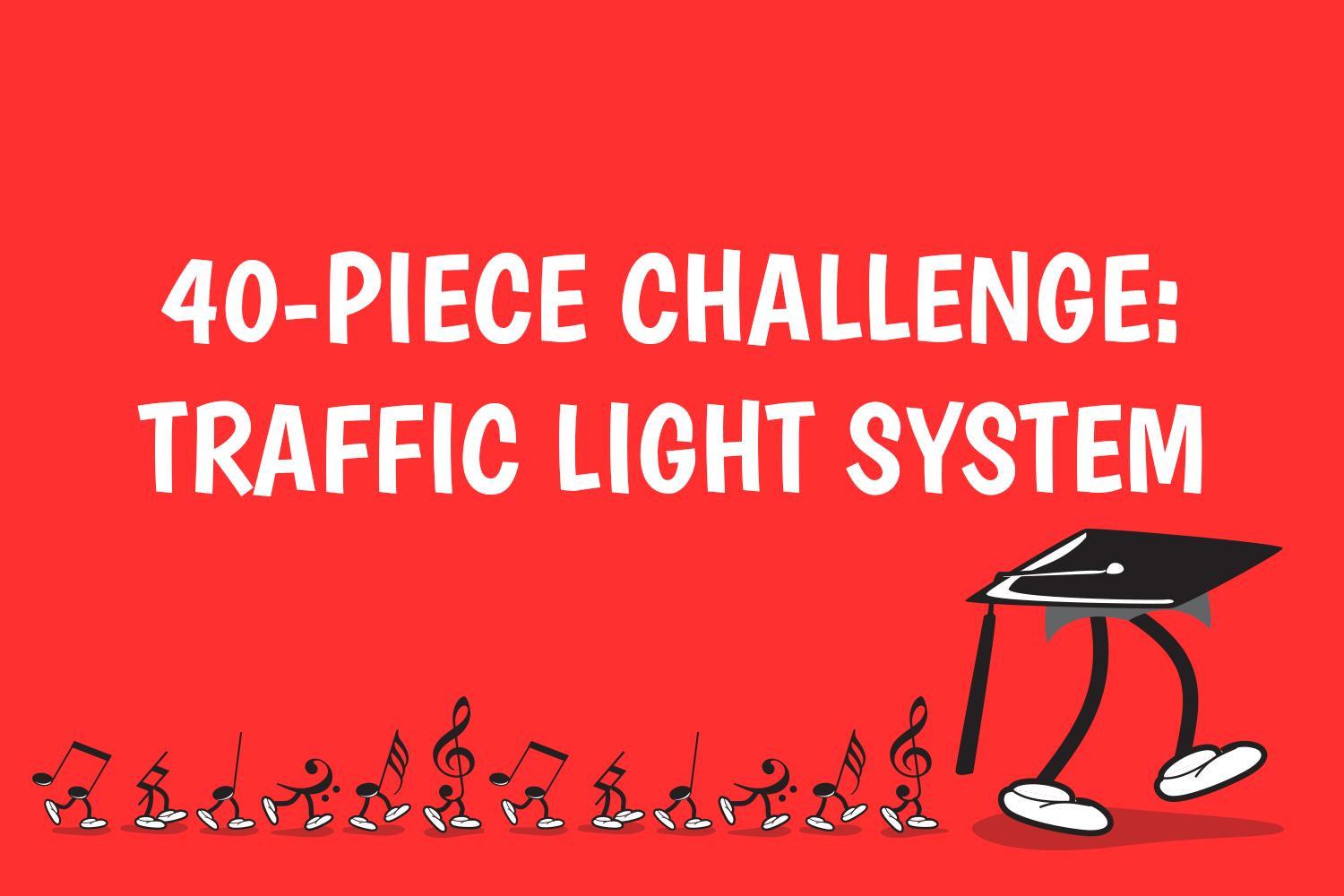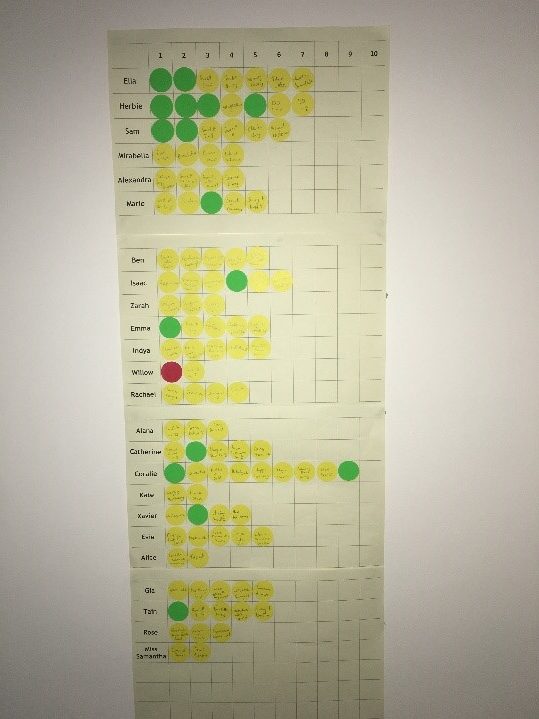40-Piece Challenge: Traffic Light System

EDIT: It is now five months since I published this post, so at the end I have put an updated photo of the chart!
Like many teachers around the world, there have been several times in my teaching career where I have run the 40 piece challenge, or at least something like it, across my studio. This year I am doing it again, with a tweak in the approach that acknowledges an important part of the process of learning repertoire.
One of the downsides of a repertoire-learning challenge is that the students who inevitably get more ‘ticks’ on the chart are the less advanced students. Beginner and intermediate standard repertoire simply takes less time to learn. Difficult repertoire requires a lot more time and effort, and with advanced students being more time poor than ever, it is just not possible to get through 40 high-level pieces in a year.
So, the only way an advanced pianist can prosper in the 40-piece challenge is to ALSO include shorter, ‘quick win’ pieces in their repertoire line-up. The trick, however, is to motivate them to embrace this approach. Sometimes it is difficult to convince older students of the benefit of learning ‘easier’ pieces (the main benefit being that their sight-reading skills skyrocket!), so this year I came up with a bit of a twist on the usual system.
The traffic light system
There is the usual chart on the wall, and a coloured dot sticker goes on the chart for each piece. The idea is to have coloured dots showing the status of the piece.
Yellow: Started, in progress
Green: Completed
Red: Piece has been discontinued for some reason (more about this below!)
Here is a quick video rundown of how I set it up:
The BIG difference between this system and all the previous version of the 40-piece challenge I’ve run is that it celebrates the fact that a piece has been started, not just finished. Not long into the term there was LOTS of yellow, which was very exciting to see! In a repertoire-rich approach it is important to have several pieces on the boil, and this chart was motivating students (including the advanced students!) to keep adding yellow stickers. Here is what the chart looked like at the end of Week 3:

EDIT: rather than update with separate blog posts, you’ll see the changes at the end of this post!
Red dots are not a bad thing
There is absolutely nothing wrong with aborting a piece. Sometimes students fall out of love with a piece. Sometimes the piece is great but is proving too much of a technical challenge. These things happen all the time, and red dots are inevitable.
The student who received the first red dot in the photo above is an advanced student who spent a week practising the solo version of ‘Wait for It’ from Hamilton. She could play it, sort of, but then we realised that the arrangement was not all that great and she had since become excited about ‘You’ll be Back’ instead. So, we decided to abort ‘Wait for It’. It shows on the chart because she spent time on it. She was happy to be the ‘role model’ for the rest of the studio, and I certainly made sure I reinforced that point that a red dot is not a bad thing at all.
‘Challenge’ does not mean ‘Competition’
In order to run a successful studio-wide challenge, I think it’s important to have all students on board, and for everyone to understand the difference between ‘challenge’ and ‘competition’.
I always ask my students’ permission first; I confirm with them that a) they want to participate in the challenge and b) they’re happy for their progress to be shown on the wall. 1 I then go to great lengths to make sure they understand that the idea is to see how many greens THEY can get. They are not competing against each other. The chart is a visual representation of their progress and yes, it’s good (and often motivating) to see what others are doing too.
Teachers can do it too!
I decided I would participate in this challenge too. I thought it would get me practising again and it absolutely has! I plan to blog about a few discoveries I have made in this process, but mainly I’ve noticed that putting myself in the mix alleviates the competitive atmosphere. My students assume I am not competing with them – I am a fair person after all! 😊
What Counts as a Piece?
I am encouraging my students to explore repertoire and decide for themselves if something is too easy. In the lesson I get them to sight-read something ridiculously simple, something that would take almost no time to perfect, and we talk about whether that should count as a piece. Usually they say no!
I want every piece to be a learning experience for them, which it can be just from the point of view of improving their sight reading and taking a simple piece to performance level in a short time. The ‘one week wonders’ should be of a standard that they can sight-read reasonably well and then spend just a few minutes of their practice time on each day mastering/memorising it.
Re-learning and memorising an old piece is also very challenge-worthy!
My Repertoire
Something that can help older students to understand how important it is to play ‘easier’ pieces is that I am playing a lot of the same pieces that they are – simply because it’s beautiful music. There are many staples of the piano repertoire, and yes, they have been assigned to a grade, but that does not mean that once you pass that grade you shouldn’t play those pieces anymore.
One of my challenge pieces is to relearn and memorise Clair de Lune. It is on the 7th grade list. Since I am well beyond 7th grade in my ability, does this mean that I shouldn’t play Clair de Lune anymore? Not at all! It’s gorgeous and I want it in my repertoire.
Another piece I’m learning is Seven of Hearts by Kevin Olson. It has only taken me about 45 minutes to learn and memorise it (I’ve been keeping a log of my practice) 2 . But I’ve also suggested this piece to most of my late intermediate students!
In Conclusion
My goal with the 40 piece challenge this year is to help students understand that having lots of repertoire on the boil is really important.
Some pieces will inevitably be aborted, but hopefully most will be completed. And in limiting this challenge to one year, I am hoping that they will at least start 40 pieces.
It’s not a competition with each other, it’s for their own personal reward, to see how many greens that they can get.
EDIT: Here’s what it’s looking like two terms on:

EDIT: And here’s the final result at the end of the year!
